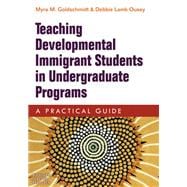Teaching Developmental Immigrant Students in Undergraduate Programs

Teaching Developmental Immigrant Students in Undergraduate Programs
- ISBN 13:
9780472034345
- ISBN 10:
0472034340
- Format: Paperback
- Copyright: 02/21/2011
- Publisher: Univ of Michigan Pr
Rent
Sorry, this item is currently unavailable.
Note: Supplemental materials are not guaranteed with Rental or Used book purchases.
Extend or Purchase Your Rental at Any Time
Need to keep your rental past your due date? At any time before your due date you can extend or purchase your rental through your account.
Summary
More and more students are entering college in the United States without the academic literacy skills needed to successfully complete their college education. One part of this population are what we refer to as developmental immigrant (DI) students; these students are usually placed into mainstream classes or developmental classes or ESL classes, which treat these students as onlymainstream, or onlydevelopmental or onlyESL learners, depending on the specialized training of the instructor. The reality for most DI students, however, is that they are all three types: they are developmental students, from (mostly) non-English speaking backgrounds, who have, for the most part, been in mainstream classes in the United States. This book provides a comprehensive framework for DI students, focusing on multiple academic literacy challenges, to help them overcome the obstacles they encounter in college. This book was written for teachers who have these at-risk DI students in their classes are not sure how to teach them. The authors of this book were involved in the creation of a successful program that addresses the needs of DI students. This guide provides a forum for them to share their lessons, both literally and figuratively, with those faculty who are, or who will be, fortunate enough to teach DI students. This book is divided into three parts, and each chapter begins with the key points highlighted in the chapter. Part I, Developmental Immigrant Students and Academic Literacy (Chapters 1-2), details the challenges faced by DI students and the faculty that teach them and describes some programming options. Part II, Partnering with Campus Support Programs (Chapters 3-4), discusses using a collaborative approach, partnering with learning and writing centers, and/or advising staff and appropriate administrators, in order to maximize DI student benefits in higher education. Part III, Teaching Literacy within an Academic Framework: Suggested Approaches (Chapters 5-9), provides specific approaches that the authors have found particularly beneficial in teaching DI students. Each chapter identifies specific goals to address problematic issues for the DI students. The suggested approaches to meet each goal are intentionally specific to provide teachers across the disciplines with concrete activities and methods that can be implemented and built on in their own classrooms






